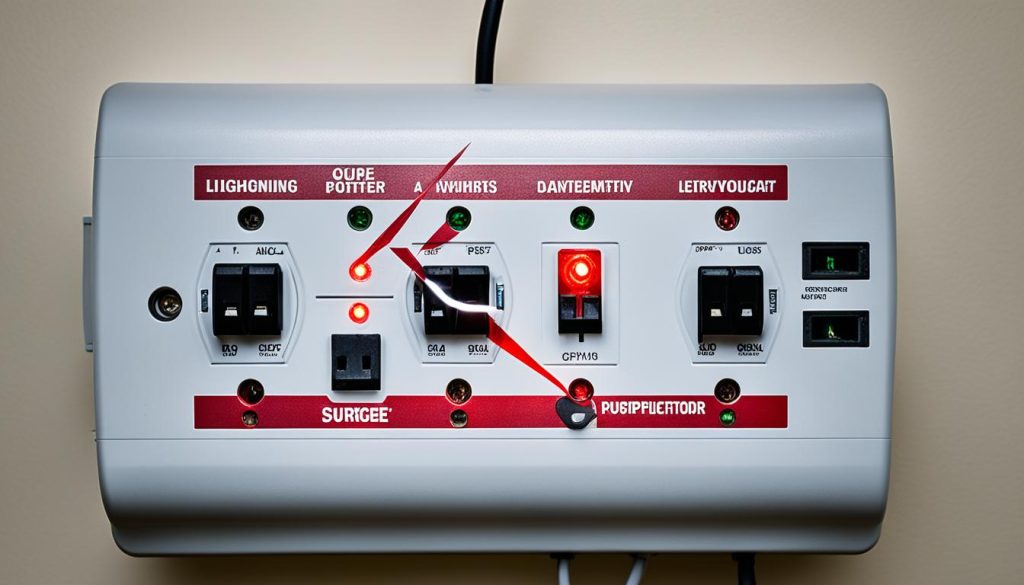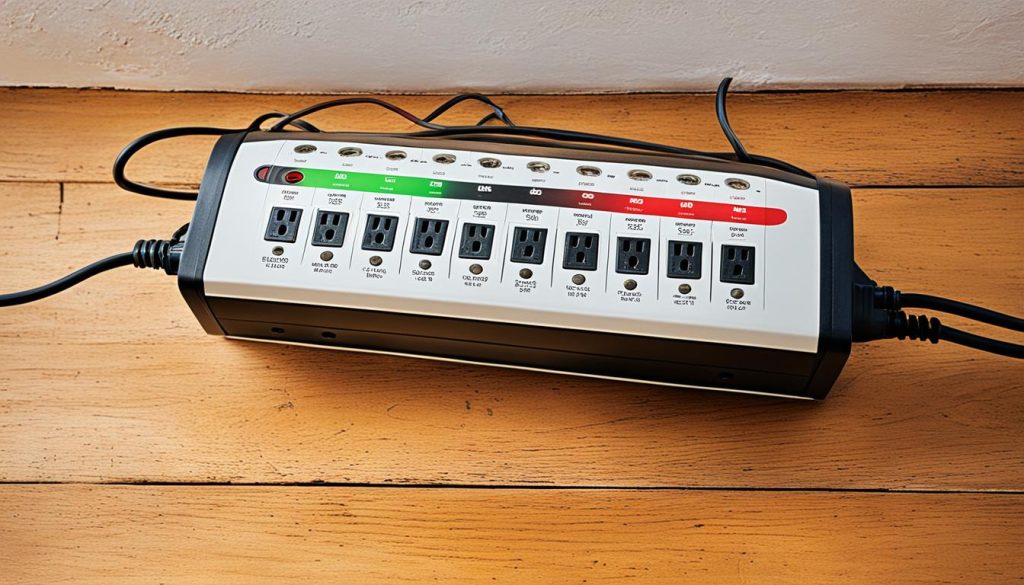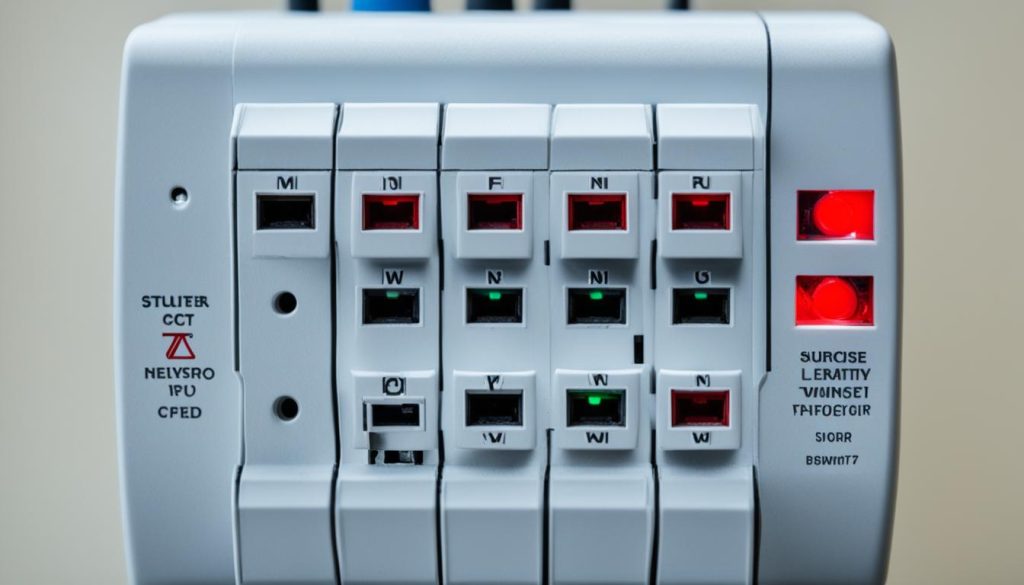Power surge protectors are essential for protecting your home electrical appliances from power surges. However, over time, surge protectors can wear out or degrade, leaving your electronics vulnerable. It’s important to be able to identify the signs of a faulty surge protector so that you can take the necessary steps to ensure the safety of your electrical devices.
There are several indicators that can help you determine if your surge protector is not working properly. Signs of a bad surge protector include a non-functional or flickering indicator light, overheating, and a surge protector that has been in use for several years. These symptoms can indicate that your surge protector may have reached its lifespan or experienced a power surge that compromised its functionality.
If you suspect that your surge protector is failing, there are troubleshooting steps you can take to test its effectiveness. Checking for a blinking light on the device can give you a preliminary indication of whether it’s still functioning. For a more accurate assessment, you can use a surge protector tester tool specifically designed for this purpose.
It’s important to note that surge protectors should be regularly checked and replaced if they show signs of failure. Worn-out surge protectors that are more than ten years old should be replaced, as well as those that have reached their joule capacity or exhibit signs of overheating. By staying vigilant and proactive in monitoring the condition of your surge protectors, you can effectively protect your electronics from power surges.
Key Takeaways:
- Inspect your surge protector regularly for signs of failure, such as a non-functional indicator light or overheating.
- Replace surge protectors that are more than ten years old, as they are likely to be worn out and less effective.
- Use a surge protector tester tool to check for functionality and ensure optimal protection.
- Never ignore signs of a failing surge protector, as it can leave your electrical devices vulnerable to power surges.
- Invest in high-quality surge protectors and replace them periodically to maintain the protection of your valuable electronics.
Signs of a Failing Surge Protector
If you suspect that your surge protector may be failing, there are several signs to look out for. Identifying these indicators of a faulty surge protector can help you take the necessary steps to protect your electronics. Here are some common symptoms of a defective surge protector:
- Flickering or non-functional indicator light: A surge protector’s indicator light is designed to show if it is actively protecting your devices. If you notice that the light is flickering or not illuminated at all, it could be a sign of a failing surge protector.
- Age and usage: Surge protectors have a limited lifespan, typically ranging from 3 to 5 years. If your surge protector has been in use for several years, it’s a good idea to consider replacing it, even if it appears to be functioning properly.
- Joule capacity reached: Surge protectors have a joule rating that indicates the amount of energy they can absorb before becoming ineffective. When a surge protector reaches its joule capacity, it can no longer provide adequate protection. Keep track of the number of power surges your surge protector has experienced, as this can help determine if it’s time for a replacement.
- Overheating: A surge protector that exhibits signs of overheating, such as a hot or burning smell, should be taken as a warning sign. Overheating can indicate internal issues and compromise the performance of the surge protector.
“If you notice any of these signs, it’s important to address the issue promptly. Continuing to use a failing surge protector can put your valuable electronics at risk.”
Visual Guide: Signs of a Failing Surge Protector
To help you identify the signs mentioned above, refer to the following visual guide.
| Signs of a Failing Surge Protector | Indicators |
|---|---|
| Flickering or non-functional indicator light | |
| Age and usage |  |
| Joule capacity reached |  |
| Overheating |  |
How to Test a Surge Protector
Testing a surge protector is essential to ensure it is functioning properly and effectively protecting your electrical devices. There are a few simple methods you can try to troubleshoot a faulty surge protector and determine if it is not working:
- Check for a blinking light: Many surge protectors have an indicator light that shows if they are working correctly. If you notice the light blinking or turning on and off, it could indicate an issue with the surge protector.
- Use a surge protector tester tool: Invest in a specialized tester tool designed for surge protectors. This tool can provide a more accurate assessment of the surge protector’s functionality and help identify any problems.
If you’ve followed these troubleshooting steps and the surge protector looks damaged, burned, or has visible signs of wear and tear, it’s best to replace it. Testing a severely damaged surge protector can be dangerous, so it’s always better to err on the side of caution.

Remember, a surge protector is a critical component in safeguarding your electrical devices. Regularly testing and replacing surge protectors when needed ensures the continued protection of your valuable electronics.
When to Replace a Surge Protector
Surge protectors are essential for safeguarding your electrical devices from power surges. However, they have a limited lifespan and can degrade over time. It’s important to know when to replace your surge protector to ensure continued protection for your valuable electronics.
Here are some signs that indicate your surge protector needs replacement:
- The surge protector is more than a few years old. Even if it appears to be functioning properly, it’s recommended to replace it every few years to maintain optimal protection.
- You experience a power surge. If your surge protector has recently been subjected to a power surge, it may no longer be effective in preventing damage to your devices.
- The surge protector shows physical signs of deterioration, such as frayed wires, cracks, or scorch marks. These signs indicate that the surge protector may be compromised and should be replaced immediately.
- You notice frequent voltage fluctuations or power interruptions. If your surge protector no longer provides consistent power supply, it’s a clear indication that it needs replacement.
Regularly checking for these signs and promptly replacing your surge protector when necessary will ensure that your electrical devices remain safe from power surges and potential damage.
Remember, investing in a new surge protector is a small price to pay compared to the cost of replacing or repairing damaged electronics.
| Signs that Your Surge Protector Needs Replacement |
|---|
| Surge protector is more than a few years old |
| Recent power surge |
| Physical signs of deterioration (frayed wires, cracks, scorch marks) |
| Frequent voltage fluctuations or power interruptions |
Replacing your surge protector at the right time will ensure that your electronics stay protected, providing you with peace of mind and saving you from potential damage and costly repairs.
The Importance of Surge Protectors
Surge protectors play a crucial role in protecting your electronics from power surges, which can cause significant damage. They act as a barrier between your electrical devices and the power source, redirecting excess voltage and preventing it from reaching your devices.
Without a surge protector, power surges can cause irreversible damage to your electronics. Imagine the frustration and financial loss of having your computer or TV fried by a power surge. By investing in high-quality surge protectors, you can safeguard your valuable devices from unexpected electrical fluctuations.
Regularly replacing surge protectors is essential for maintaining their effectiveness. Over time, surge protectors can wear out or degrade, compromising their ability to provide adequate protection. As technology advances, newer surge protector models with improved features become available, ensuring better defense against power surges.
Don’t take chances with the safety of your electronics. Be proactive and include surge protectors as an essential part of your electrical setup. Remember, it’s far more cost-effective to invest in surge protectors than to replace damaged or destroyed devices. Keep your electronics safe and enjoy peace of mind knowing that you have taken the necessary steps to protect them.
In addition to their protective function, surge protectors also offer convenience. With multiple outlets, you can power multiple devices simultaneously and eliminate the hassle of constantly swapping plugs. Surge protectors are a must-have for anyone who values the safety and longevity of their electronics.
Notable Benefits of Surge Protectors:
- Protection against power surges and voltage spikes
- Preservation of electronic devices and appliances
- Convenience of multiple outlets
- Peace of mind knowing your electronics are safeguarded
Investing in surge protectors is a small price to pay for the peace of mind and long-term protection they provide. Don’t leave your electronics vulnerable to the unpredictable nature of power surges. Take the necessary precautions and make surge protectors an essential part of your home or office.
Additional Tips for Electrical Safety
When it comes to electrical safety in your home, using surge protectors is just one piece of the puzzle. There are several additional steps you can take to ensure the protection of your electrical devices and safeguard against power surges.
First and foremost, it’s important to avoid overloading outlets. Plugging too many appliances or devices into a single outlet can cause it to overheat and potentially lead to a fire or electrical damage. Spread your devices across multiple outlets and use power strips or extension cords with built-in surge protection.
Regularly checking for loose or damaged electrical connections is another crucial safety measure. Loose or frayed wires can increase the risk of electrical shocks or fires. Ensure all your electrical connections are secure and intact, and promptly address any signs of damage or wear.
In areas where water is present, such as bathrooms and kitchens, it’s essential to install ground fault circuit interrupters (GFCIs). GFCIs are designed to quickly detect electrical faults and shut off the power to prevent electrical shock. These devices provide an extra layer of protection against electrical hazards.
Lastly, it’s highly recommended to have a licensed electrician inspect your electrical system regularly. A professional electrician can identify and address any potential hazards, ensuring that your electrical system is up to code and functioning properly. Regular inspections can help prevent electrical emergencies and keep your home safe from power surges.
By following these additional tips for electrical safety, you can enhance the protection of your home and minimize the risk of electrical damage. Remember to prioritize safety in all your electrical endeavors to keep your home and loved ones safe.
FAQ
How can I tell if my surge protector is bad?
There are several signs that can indicate a failing surge protector. These include a flickering or non-functional indicator light, a surge protector that has been in use for several years, a surge protector that has received multiple “hits” and reached its joule capacity, and a surge protector that exhibits signs of overheating.
What are the signs of a failing surge protector?
Signs of a failing surge protector include a flickering or non-functional indicator light, a surge protector that has been in use for several years, a surge protector that has reached its joule capacity, and a surge protector that exhibits signs of overheating.
How do I test a surge protector?
One way to test a surge protector is to check for a blinking light on the device, as this can indicate whether it’s working or not. Additionally, using a tester tool specifically designed for surge protectors can provide a more accurate assessment of its functionality. If a surge protector looks damaged or burned, it’s best to replace it rather than trying to test its effectiveness.
When should I replace my surge protector?
It’s recommended to replace surge protectors periodically, even if they appear to be functioning properly. Surge protectors have a limited lifespan and can degrade over time, so it’s best to err on the side of caution and replace them every few years. Additionally, if you experience a power surge or notice any signs of a failing surge protector, it’s important to replace it immediately.
What is the importance of surge protectors?
Surge protectors play a crucial role in protecting your electronics from power surges, which can cause significant damage. They act as a barrier between your electrical devices and the power source, redirecting excess voltage and preventing it from reaching your devices. Without a surge protector, power surges can cause irreversible damage to your electronics.
Are there any additional tips for electrical safety?
In addition to using surge protectors, you can ensure electrical safety in your home by avoiding overloading outlets, regularly checking for loose or damaged electrical connections, and installing ground fault circuit interrupters (GFCIs) in areas where water is present, such as bathrooms and kitchens. It’s also important to have a licensed electrician inspect your electrical system regularly to identify and address any potential hazards.


